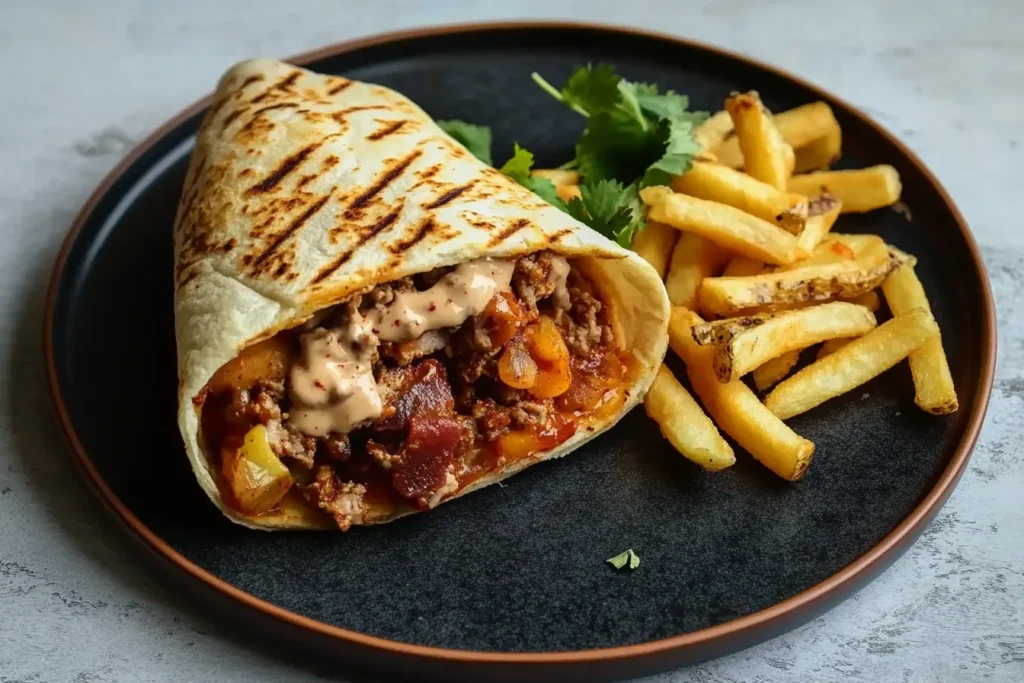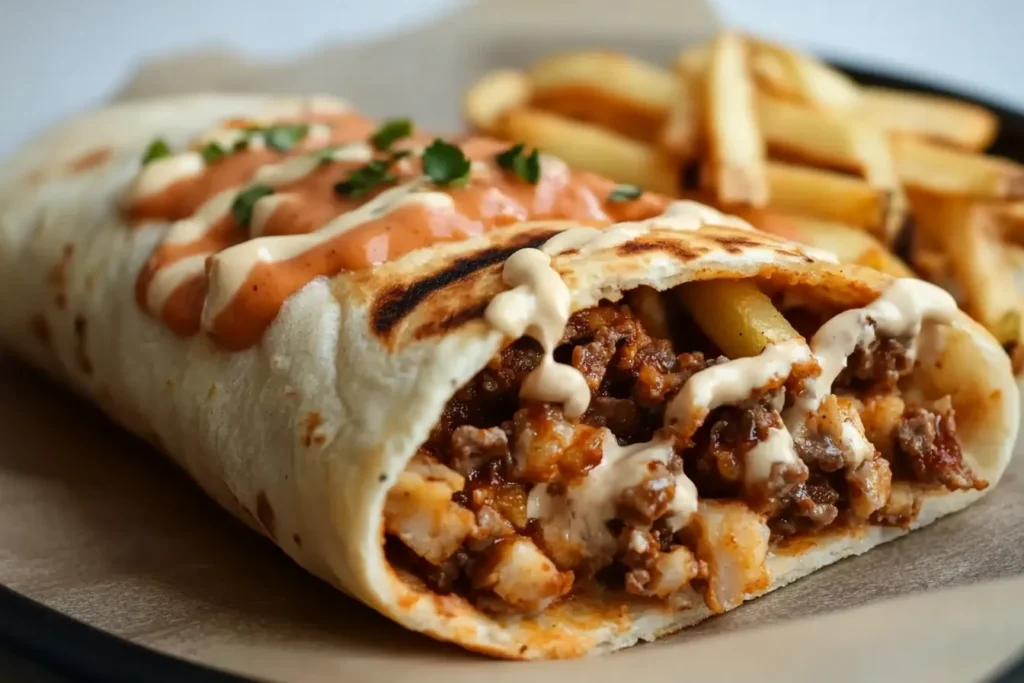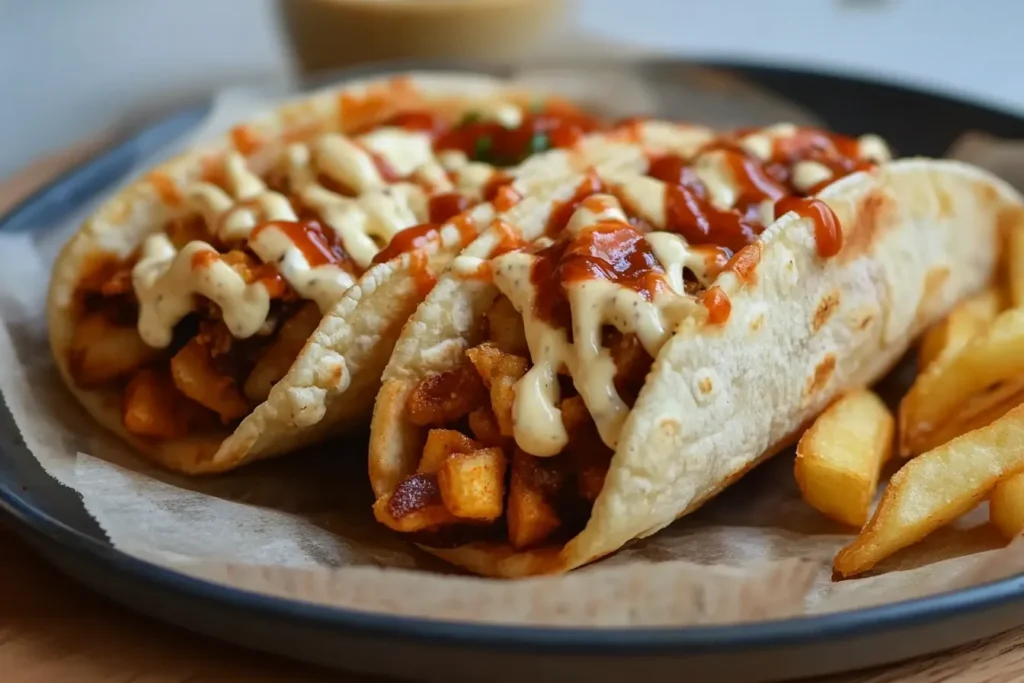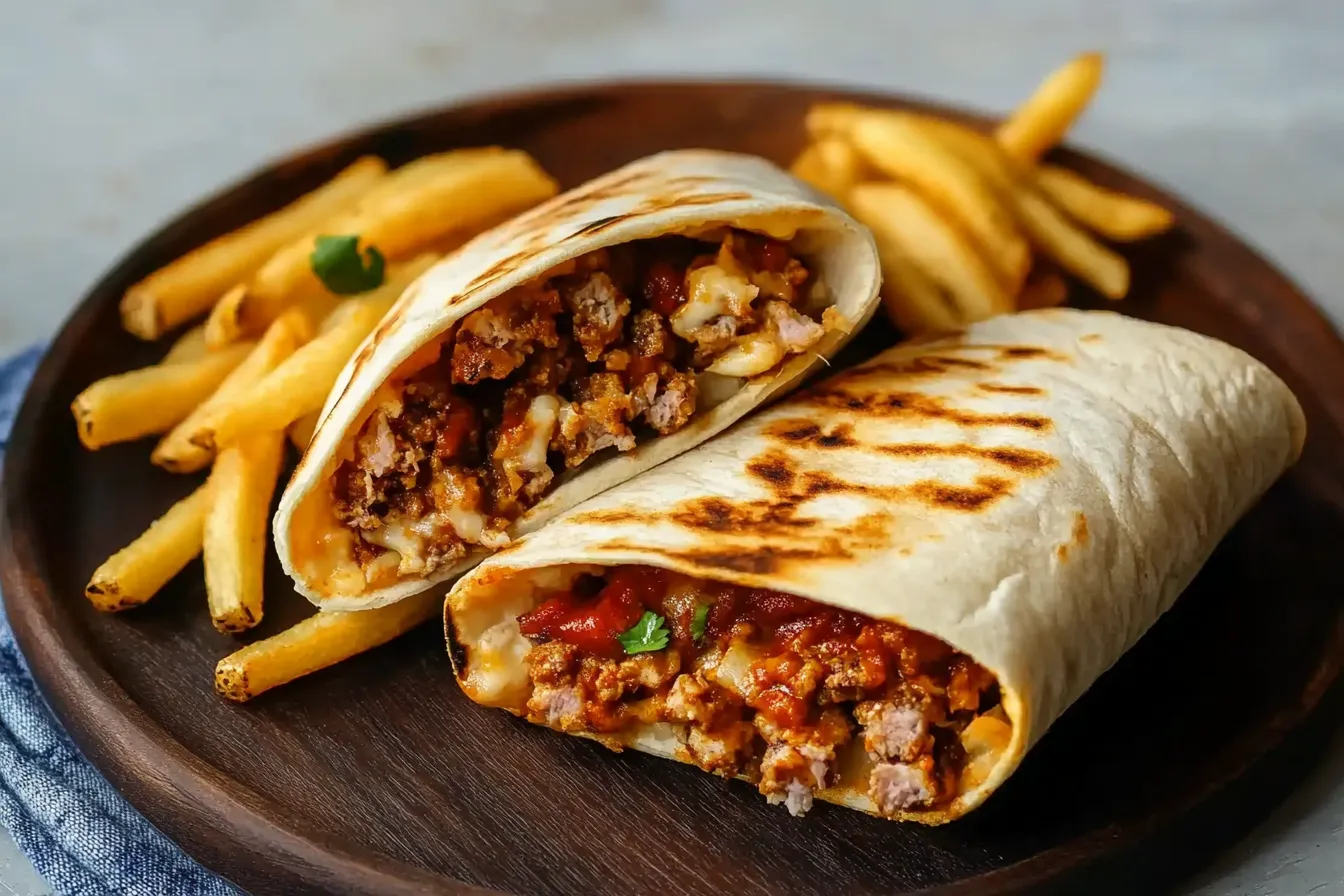Have you ever bitten into a French taco and thought, Isn’t this just a burrito with a fancy name? You’re not alone. Many of us love exploring new foods but struggle to understand the subtle (and sometimes not-so-subtle) differences between dishes that seem so similar. Whether you’re a foodie looking to expand your culinary knowledge or simply someone trying to settle a debate with friends, understanding what makes French tacos and burritos unique can make your next meal even more enjoyable. Let’s break it down together and uncover the fascinating stories and flavors behind these two popular dishes.
Introduction to French Tacos and Burritos
At first glance, French tacos and burritos may seem like culinary cousins. Both dishes involve a tortilla wrapped around a variety of fillings, but their origins, ingredients, and cultural significance are vastly different. This article explores the history and defining characteristics of these two popular foods, breaking down what truly sets them apart.
The Origins of French Tacos
French tacos were born in the suburbs of Lyon, France, in the early 2000s. This innovative fast-food creation emerged from the culinary ingenuity of North African immigrants who combined French food culture with Middle Eastern and North African influences. Initially popular among younger, multicultural communities, French tacos quickly spread across France and Europe due to their customizable nature and bold flavors.
Unlike traditional tacos or burritos, French tacos are square-shaped and filled with a blend of meat, fries, cheese, and creamy sauces. This hearty combination reflects a fusion of cultural influences, appealing to diverse palates and redefining fast food in Europe. Check out more recipes here.
Tracing the History of Burritos: A Mexican Classic
The burrito, on the other hand, is deeply rooted in Mexican cuisine. Its name, which means “little donkey” in Spanish, is thought to refer to its rolled shape, resembling a donkey’s saddlebag. Originating in northern Mexico, burritos were created as a practical, portable meal for workers. Traditionally, they consist of a flour tortilla filled with beans, rice, meat, and occasionally cheese or salsa.
As Mexican cuisine spread globally, burritos evolved. In the United States, particularly through Tex-Mex cuisine, they became larger and more diverse, with ingredients like guacamole, sour cream, and grilled vegetables becoming common additions. Despite these changes, burritos have retained their connection to Mexican culinary traditions.

What Makes a Taco French?
How French Tacos Were Invented in France
The creation of French tacos reflects the unique blend of cultures in France. North African immigrants adapted the concept of wraps, using tortillas instead of traditional flatbreads, and incorporated local tastes. A typical French taco includes marinated meats such as chicken, beef, or lamb, along with French fries and a choice of creamy sauces like Algerian or white garlic sauce.
Grilled to perfection, the taco’s signature square shape and crispy exterior set it apart. Its compact design and indulgent fillings make it a popular choice for quick, satisfying meals. Check out more recipes here.
Fusion of Cultures: The Influence of Fast Food on French Cuisine
French tacos highlight how global influences have shaped modern French food culture. Fast food, often associated with American chains, has been reimagined in France with a multicultural twist. French tacos are a prime example of this evolution, blending elements of Mexican, Middle Eastern, and French cuisines into a single dish that resonates with a broad audience.
A Quick Overview of Burritos
The Anatomy of a Traditional Burrito
Burritos are a staple of Mexican cuisine, known for their simplicity and versatility. A traditional burrito consists of a soft flour tortilla filled with seasoned meat, beans, and rice, often accompanied by salsa and cheese. This combination offers a balanced and flavorful meal that’s easy to transport, making it a practical choice for workers and travelers.
Modern Burritos: Variations and Innovations
Over time, burritos have adapted to different culinary traditions and preferences. In the United States, Tex-Mex burritos are larger and often include ingredients like shredded lettuce, sour cream, guacamole, and even non-traditional options such as tofu or roasted vegetables. Chain restaurants like Chipotle have further expanded the burrito’s appeal, allowing for endless customization.
Despite these modern innovations, burritos maintain their essence as a versatile and satisfying dish that showcases the richness of Mexican cuisine. Check out more recipes here.
Ingredients Used in French Tacos
French tacos have carved out a distinct identity through their innovative use of ingredients. While the term “tacos” might evoke images of traditional Mexican fare, French tacos stand out due to their rich, indulgent fillings and creative combinations.
Meat, Cheese, and Sauce Combos
French tacos often feature marinated or grilled meats such as chicken, beef, or lamb, which are seasoned with spices that reflect a blend of French, North African, and Middle Eastern culinary traditions. Cheese is a prominent component, not just as a topping but as a melted, gooey layer that binds the other ingredients together.
The sauces in French tacos are unique and plentiful. Options range from creamy garlic and tangy Algerian sauce to spicy harissa and barbecue flavors. These sauces not only enhance the taste but also give French tacos their signature richness.
The Role of Fries in French Tacos
Perhaps the most distinguishing feature of French tacos is the inclusion of French fries inside the tortilla. This addition brings an extra layer of texture, combining the softness of the wrap with the crunchiness of the fries. It’s a reflection of French fast food preferences and sets the dish apart from burritos or traditional Mexican tacos.
Burrito Ingredients: A Traditional Mexican Approach
Burritos, rooted in Mexican culinary tradition, focus on fresh and wholesome ingredients. While they have evolved over time, their essence remains tied to the simplicity of their origins.
Rice, Beans, and Fresh Vegetables
Rice and beans are the foundation of many burritos, providing both sustenance and a neutral base that complements the other flavors. These staples are often combined with seasoned meats like carnitas, barbacoa, or grilled chicken. Fresh vegetables such as lettuce, tomatoes, and onions add crunch and brightness. Check out more recipes here.
Salsa, Guacamole, and Mexican Cheeses
Salsa and guacamole are iconic components of a burrito. Whether it’s a spicy red salsa or a tangy green tomatillo variety, these sauces infuse the dish with vibrant flavors. Mexican cheeses, such as queso fresco or shredded Oaxaca cheese, add creaminess and enhance the overall taste.
While modern burritos may include global influences, they continue to showcase the vibrant, earthy flavors of Mexican cuisine.
Preparation and Cooking Techniques
How these two dishes are prepared also highlights their differences, from the wrapping process to the final cooking methods.

Grilling French Tacos: A Crisp Outer Layer
French tacos are grilled after being assembled, giving them a crisp, golden-brown exterior. This step not only enhances the flavor but also ensures that the fillings are heated evenly, allowing the cheese to melt and the flavors to meld together. The square shape makes them easy to stack and grill, further setting them apart from their Mexican counterparts.
Rolling Burritos: A Delicate Balance of Flavors
Burritos are rolled tightly into a cylindrical shape, ensuring that the fillings are evenly distributed in every bite. They are typically served as-is, without additional grilling, allowing the freshness of the ingredients to shine. In some cases, burritos are lightly toasted on a griddle to warm the tortilla, but this step is more common in Tex-Mex variations.
The Shape and Presentation
The visual and structural differences between French tacos and burritos are immediately noticeable.
Square-Folded French Tacos vs. Cylindrical Burritos
French tacos are folded into a square or rectangular shape, emphasizing portability and a compact design. This unique presentation makes them easy to hold and eat, appealing to on-the-go diners.
Burritos, on the other hand, maintain a cylindrical shape that reflects their traditional roots. This design prioritizes functionality and ensures that the ingredients are tightly packed for easy consumption.
French Tacos: A Fast-Food Phenomenon in Europe
French tacos have grown from a niche creation into a cultural icon across Europe, particularly in France, Belgium, and the Netherlands. Their appeal lies not only in their unique flavor profile but also in their ability to adapt to a variety of tastes and dietary preferences.
Popularity Among French Millennials
French tacos resonate strongly with younger generations, particularly millennials and Gen Z. The dish’s affordable price point, customizable options, and indulgent flavors make it a favorite choice for students and young professionals. Social media has also played a significant role in popularizing French tacos, with influencers and food bloggers showcasing elaborate versions of the dish.
Additionally, the ability to cater to halal dietary restrictions has made French tacos a staple among diverse communities in urban areas, contributing to their widespread appeal.
The Role of French Tacos in Social Media Trends
French tacos have become a sensation on platforms like Instagram and TikTok, where their square shape, grilled exterior, and oozing cheese make them highly photogenic. The rise of food challenges, such as eating oversized French tacos or creating extreme flavor combinations, has further fueled their popularity online.
These social media trends have turned French tacos into more than just a meal—they are now a symbol of creativity and indulgence in fast food culture.
Burritos as a Mexican Culinary Staple
While French tacos have made waves as a fast-food innovation, burritos hold a deeper cultural significance as a cornerstone of Mexican cuisine.
Symbol of Mexican Food Culture Globally
Burritos represent the heart of Mexican culinary traditions, combining practicality with bold, authentic flavors. As Mexican food gained global recognition, the burrito became one of its most recognizable exports, often serving as an introduction to the richness of Mexican cuisine.
Unlike French tacos, burritos are celebrated for their simplicity and emphasis on fresh ingredients. Their enduring popularity reflects the universal appeal of Mexican cooking, which balances earthy flavors with vibrant spices and salsas. Check out more recipes here
Street Food to Gourmet: The Burrito Evolution
Burritos began as humble street food, designed for workers needing a quick, filling meal. Over time, they transitioned into gourmet territory, with chefs and restaurants reimagining the dish using high-quality ingredients and artistic presentation.
Today, burritos can be found in a wide range of settings, from food trucks to upscale restaurants, showcasing their versatility and timeless appeal.
Modern Innovations in Both Dishes
While both French tacos and burritos have distinct cultural roots, they share a common thread of innovation and adaptation in the modern culinary world.

Gourmet French Tacos: Upscaling the Trend
As French tacos gained popularity, some chefs began elevating the dish by incorporating premium ingredients like duck confit, truffle oil, or aged cheeses. These gourmet versions appeal to food enthusiasts who enjoy reimagined comfort foods.
Restaurants specializing in French tacos have also experimented with unique fillings, such as vegan options or regional flavors inspired by cuisines from around the world. This constant reinvention has helped keep French tacos relevant and exciting.
Fusion Burritos: Global Ingredients Meet Mexican Roots
Burritos have similarly embraced global influences, resulting in fusion creations that blend Mexican techniques with international flavors. Sushi burritos, for example, replace tortillas with seaweed wraps and rice, while Korean-inspired burritos feature bulgogi beef and kimchi.
This fusion approach highlights the adaptability of burritos, allowing them to evolve while staying true to their Mexican heritage.
Conclusion: Are French Tacos Really Burritos?
While French tacos and burritos share some superficial similarities, they are ultimately distinct culinary creations. Each dish reflects its own unique cultural and historical influences, resulting in differences in ingredients, preparation, and presentation.
Key Takeaways on the Differences and Similarities
- French tacos are square-shaped, grilled, and include non-traditional ingredients like fries and rich sauces.
- Burritos are cylindrical, focus on fresh and wholesome Mexican flavors, and typically omit heavy sauces or fried elements.
- Both dishes showcase the versatility of tortillas and highlight how global cuisines can adapt to local tastes.
Celebrating Both as Unique Culinary Creations
Rather than viewing French tacos as a variation of burritos, they should be celebrated as their own distinct innovation. French tacos reflect the fusion of cultures in France, while burritos honor the rich culinary traditions of Mexico. Together, they demonstrate the power of food to evolve, adapt, and bring people together.
More FAQs
Here are some frequently asked questions about French tacos and burritos:
- What makes French tacos different from traditional tacos?
French tacos are folded into a square, include fries and cheese, and are grilled, unlike traditional tacos, which are smaller, open-faced, and focus on fresh ingredients. - Are French tacos popular outside of Europe?
While they are a staple in France and nearby countries, French tacos are slowly gaining popularity in other regions, particularly through social media. - Do traditional Mexican burritos include cheese?
Cheese is not a mandatory ingredient in traditional burritos, but it is often added in Tex-Mex versions. - Can French tacos be made vegan?
Yes, many restaurants offer vegan versions using plant-based proteins, dairy-free cheese, and sauces. - Why are fries included in French tacos?
Fries reflect French fast-food culture and add a unique texture to the dish. - What is the most popular sauce in French tacos?
Algerian sauce, a tangy and mildly spicy condiment, is one of the most popular choices. - Are burritos considered healthy?
Burritos can be healthy when made with fresh, wholesome ingredients, but calorie counts vary depending on the fillings and portion size. - How are French tacos grilled?
They are placed in a panini press or similar grilling device, creating a crisp outer layer. - What are the key spices in a traditional burrito?
Common spices include cumin, chili powder, oregano, and garlic, which are used to season the meat and beans. - Do French tacos taste like burritos?
While there are some flavor overlaps, French tacos have a creamier, richer taste due to their sauces and fries, making them quite different from burritos.
